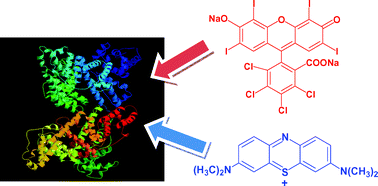Photophysics and photochemistry of dyes bound to human serum albumin are determined by the dyelocalization
Abstract
The photophysics and photochemistry of rose bengal (

* Corresponding authors
a Facultad de Química, Departamento de Química Física, Pontificia Universidad Católica de Chile, Santiago, Chile
b
Departamento de Ciencias del Ambiente, Facultad de Química y Biología, Universidad de Santiago de Chile, USACH, Av. Bernardo O'Higgins, Santiago, Chile
E-mail:
Eduardo.lissi@usach.cl
c Instituto de Química del NOA (INQUINOA-CONICET), Facultad de Agronomía y Agroindustrias, Universidad Nacional de Santiago del Estero, Santiago del Estero, Argentina
d Centro de Bio-informática, Universidad de Talca, Chile
e Faculty of Science, 10, Marie Curie, K1N 6N5, University of Ottawa, Canada
The photophysics and photochemistry of rose bengal (

 Please wait while we load your content...
Something went wrong. Try again?
Please wait while we load your content...
Something went wrong. Try again?
E. Alarcón, A. M. Edwards, A. Aspee, F. E. Moran, C. D. Borsarelli, E. A. Lissi, D. Gonzalez-Nilo, H. Poblete and J. C. Scaiano, Photochem. Photobiol. Sci., 2010, 9, 93 DOI: 10.1039/B9PP00091G
To request permission to reproduce material from this article, please go to the Copyright Clearance Center request page.
If you are an author contributing to an RSC publication, you do not need to request permission provided correct acknowledgement is given.
If you are the author of this article, you do not need to request permission to reproduce figures and diagrams provided correct acknowledgement is given. If you want to reproduce the whole article in a third-party publication (excluding your thesis/dissertation for which permission is not required) please go to the Copyright Clearance Center request page.
Read more about how to correctly acknowledge RSC content.
 Fetching data from CrossRef.
Fetching data from CrossRef.
This may take some time to load.
Loading related content
